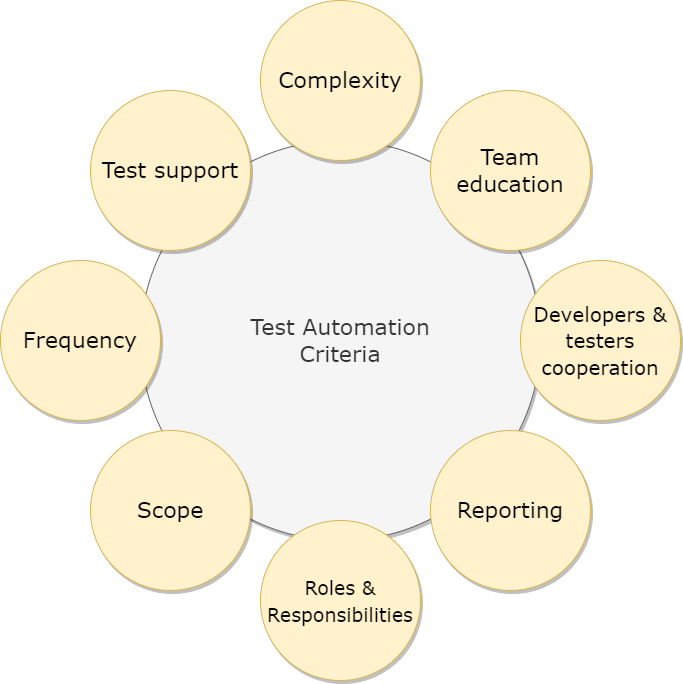
Most organizations today are striving to develop automated test cases but not all do so. Manual test cases are mostly something they start to create especially when the project is started from scratch. When the time comes to migrate towards automation, we need to re-evaluate the state of the already written manual test cases and choose which of them can be converted into automated tests, which can be removed or new ones may be developed to cover the removed ones, etc.
It’s clear that not all tests can and should be automated but the goal should be automation coverage as much as possible and testing early during STLC.
Even though there are many challenges in test automation, one must consider the long-term solution for the organization’s quality aspect. Migrating towards automation is not an easy a straightforward job so some of the most important test automation criteria must be satisfied first.
Test Automation Criteria
The most important test automation criteria that need to be covered first are:
- Execution frequency
- Complexity
- Team education
- Reporting
- Scope
- Roles & Responsabilities
- Test support
- Devs and testers collaboration
We’ll go through each of them in detail and why they are important and what end result they will bring when we fulfill them.

Complexity
In a situation where a complex application needs to be tested for quality, there may be an enormous benefit of using test automation. This will greatly reduce the manual repetitive tasks and complex steps that are hard to execute manually and are time-consuming. However, some challenges can arise like:
- Compatibility betwwen the app adn the test automation framework
- Effort to created autoamted test scripts
- Total number of apps or third party systems that need to be included in the test autoamtion
- Amount of time needed to test the scripts
Team education
Many QA’s come from a different background, some are manual testers that may have great domain knowledge and others may have strong technical skills. Nevertheless, for testing to be effective a mix of multiple backgrounds is preferable.
Educating all the members early is important in order to avoid anxiety or stress of the roles they will have. Shifting towards automation early and incorporating all the QA’s background and leveraging their skills for the benefit of the project while educating them on how to automate is a must.
Developers & testers cooperation
Migrating towards test automation shouldn’t be only a tester’s job. Developers must be able to help and provide some knowledge regarding developing approaches and code patterns followed. Working closely together can result in more optimized code, understandable and flexible enough while all the standards are followed.
Reporting
What’s the purpose of automating test cases when you cannot see the test report at the end of execution? Make sure you have proper reporting that may include pass/fail status, overall test execution statistic, test performance results, etc.
Roles & Responsibilities
Automating should be everyone’s activity but not everyone’s role. All that is related to designing, implementing, and executing automated tests needs to be reserved for engineers with strong programming skills. Creating the test environment can be reserved for DevOps engineers in collaboration with QAs. Manual testers with great domain knowledge can help the automation engineers to set up all the positive and edge-case scenarios for a particular functionality. Developers can suggest some code approaches or libraries that can help the test automation overall. All in all, everyone should impact the test automation in a way that can result in having an optimized and stable test.
Scope
One of the most important test automation criteria that the teams must include. In order to gain feedback or to show the early success of automation, the team needs to define the scope of test automation. One way is to choose a single feature as a pilot project and try automating the tests that require little effort to implement but provide a high value in return. These can be considered as smoke test suites where they are executed often on a daily basis and are covering the basics. Lessons learned from the pilot project can be transferred onto the next functionalities and so on.
Priotizitaion of the most important tests needs to be decided by the test team as these tests can show the overall quality of the product. The most challenging tests need to be avoided for the time being since they are complex to implements, even though they are bringing value, however, they need a certain strategy and approach before actual implementation.
Frequency
There are tests that are executed more often than the others as part of a release cycle. The more release we trigger the greater benefit we will have from automated tests. Why? Because they can be set as part of the regression test suite and can be executed on every release to satisfy the DoD. Also, automated tests used in the regression test suites will provide high ROI.
If a test is run a couple of times a year, the time needed to update the test may not be feasible to do, so, manual effort should be a preferred choice.
Test support for ROI
The last but not least criterion from the test automation criteria is the support for testing of ROI analysis. Like any other goal, automation requires a significant level of effort and resources to implement. Before the actual implementation, an analysis should be made and it should be intended towards a potential benefit and a long-term solution to the organization. After that, a test plan should be defined, and ROI calculations to be performed.
Share This Post
Latest Posts
- Test Analyst’s Responsibilities in Risk-Based Testing
- Crucial Aspects Of Superior Test Code Quality
- Streamline Your Cucumber BDD Tests with Gherkin Lint: A Comprehensive Guide
- How to Test Authentication and Authorization with Confidence + Best Tips
- Exploring the Three Scrum Artifacts: Grasping Their Essence and Effective Utilization











